Date : June 1 - 2, 2022
Fukushima Press Tour
post date : 2022.05.11
Fukushima Press Tour
Tour Dates: Wednesday, June 1- Thursday, June 2, 2022
Sponsored by the Ministry of the Environment
[Tour Topics]
Environmental Remediation and the Current State of Fukushima’s Reconstruction
The majority of the town of Futaba, Fukushima, where the TEPCO Fukushima Daiichi Nuclear Power Plant is located, was designated as “difficult-to-return zones,” and is the only municipality around the plant with all its residents still having to live as evacuees. However, plans are in place to lift evacuation orders for the Specified Reconstruction and Revitalization Base in Futaba in June or later.
The Great East Japan Earthquake and nuclear accident caused unprecedented damage, but with decontamination and disposal of contaminated waste being carried out at a scale and with methods never seen before in the world, Fukushima’s environmental remediation has been steadily progressing. Surface decontamination was completed in March 2018, excluding the difficult-to-return zones. Infrastructure including roads and railways in Fukushima Prefecture has been rebuilt, and evacuation orders lifted, with the recovery from the nuclear disaster well underway. Even in difficult-to-return zones, preliminary decontamination and infrastructure building has been carried out in areas such as town centers designated as Specified Reconstruction and Revitalization Bases, and evacuation orders have been lifted in some areas. However, reconstruction still faces some issues, such as only some residents having returned and the final disposal outside the prefecture of removed soil and waste in Fukushima.
This tour will visit Futaba and other municipalities in the area, covering the current state of Fukushima, including its environmental remediation and remaining issues, and efforts by people working towards Fukushima’s recovery and its future.
<List of Stops on This Press Tour>
Ministry of the Environment Briefing, Interim Storage Facility, Demonstration Project for Recycling (Nagadoro, Iitate Village), Great East Japan Earthquake and Nuclear Disaster Memorial Museum, Futaba Town, the area around JR Futaba Station, Tomioka Wine Domaine, Namie Town, Fukushima Hydrogen Energy Research Field (FH2R)
【Overview】
1.Initiatives for Fukushima’s Environmental Remediation
(1) Ministry of the Environment Briefing
The Ministry of the Environment has carried out an environmental remediation project at a scale and with methods not seen before, decontaminating over 400,000 residences and 500 square kilometers of soil in Fukushima Prefecture alone.
◆A Ministry of the Environment official will give a briefing on the environmental remediation project in Fukushima Prefecture since the Great East Japan Earthquake and nuclear accident occurred, and on remaining issues.
(2) Interim Storage Facility
Large quantities of soil and waste including radioactive material have been generated from decontamination efforts in Fukushima Prefecture. The Interim Storage Facility was built to provide a safe, centralized place to manage and store removed soil and waste until it can be permanently disposed of. The massive facility is 16 square kilometers in size, straddling Okuma and Futaba. It is used to store ash with radioactivity over 100,000 Bq per kilogram, as well as soil and waste (leaves, sticks, etc.) removed as part of the decontamination process which were temporarily stored in sites around the prefecture. The removed soil and waste brought in from temporary storage sites is sorted at the soil separation facility where the soil is separated from burnable materials, and the separated soil is stored at soil storage. Transportation to the Interim Storage Facility began in March 2015, and as of the end of April 2022 a total of approximately 13 million cubic meters of removed soil and waste was transported to the facility. In the 2022 fiscal year, the facility is mainly receiving soil and waste generated by work in the Specified Reconstruction and Revitalization Bases in the difficult-to-return zones.
◆The tour will see the Soil Separation Facility and Soil Storage Facilities, and be given a briefing about them.



【Photos courtesy of MOE】
(3) Demonstration Project for Recycling (Nagadoro, Iitate Village)
According to law, the national government will take responsibility for the removed soil and waste being stored at the Interim Storage Facility and carry out its final disposal outside of Fukushima Prefecture, within 30 years of the beginning of storage (by 2045). Having determined it is critical to reduce the volume to be disposed of ahead of the final disposal outside the prefecture, the Ministry of the Environment, while prioritizing safety, is developing techniques to reduce the volume of removed soil and carrying out demonstration projects for recycling it.
One of these projects is a demonstration project for recycling removed soil being carried out in Nagadoro, the only district in Iitate Village where evacuation orders have not been lifted. Of the removed soil generated in Iitate Village, soil with a radioactivity of 5,000 Bq or less per kilogram will have foreign materials removed and be processed into recycled material. This recycled material will be used for the foundation of an embankment, covered by soil to block radiation, and turned into farmland. In addition to developing farmland, to confirm safety and productivity, embankments were built for testing and tests carried out on cultivating flowers, vegetables, and energy crops (all vegetables produced were disposed of). To compare the productivity and safety of crops, comparisons were also carried out between cultivation with the layer of soil to block radiation and without. From the 2021 fiscal year, tests are also being carried out to see if the recycled material can be used for paddy fields.
◆A Ministry of the Environment official will explain the demonstration project for recycling, and the tour will see the yard where recycled building material is made and the paddy field test area. Afterwards, the tour will hear from Mr. Yoshitomo Shigihara, who was the administrative head of Nagadoro until 2020 about the decision to accept the national government’s demonstration project being carried out in Nagadoro and his hopes for Nagadoro’s recovery.
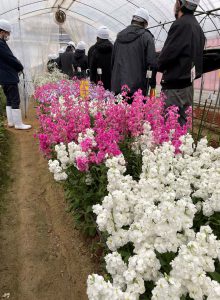
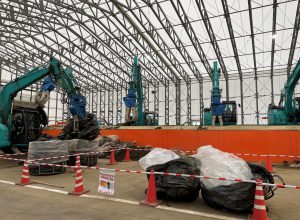
【Photos courtesy of MOE】
2. The Return of Residents and Revitalization of Towns
(1) Great East Japan Earthquake and Nuclear Disaster Memorial Museum (Futaba)
In the Industrial Recovery Base of the district of Nakano in Futaba, where evacuation orders were lifted in March 2020, the Great East Japan Earthquake and Nuclear Disaster Memorial Museum opened in September 2020. Through exhibitions and stories from survivors, this museum is made to pass on to later generations the records, memories, and lessons of the unprecedented complex disaster including earthquakes, tsunami, and a nuclear accident which Fukushima experienced, as well as showing the resilience of Fukushima Prefecture as it moves towards recovery.
◆The tour will look around the museum, and hear from a storyteller who was experienced the disaster. Staff, who were elementary school students at the time of the disaster and lived as an evacuee, about their experiences with the disaster and their hopes for Fukushima’s recovery.
*Changed: Instead of young staff, the tour will hear from a storyteller at the museum about their experiences during the disaster.
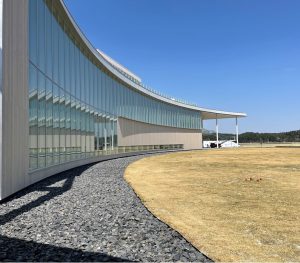
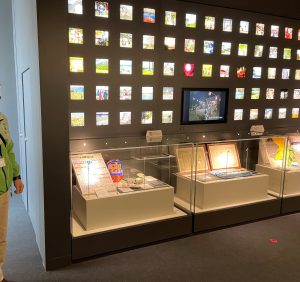
【Photos courtesy of MOE】
(2) Futaba, Welcoming Residents Back for the First Time Since the Nuclear Accident
In the town of Futaba, where the Fukushima Daiichi Nuclear Power Plant is located, all of the approximately 7,000 residents were forced to evacuate due to the nuclear accident, and 96% of the town is still designated as difficult-to-return zones. Although in the spring of 2020, evacuation orders were lifted from some areas and restrictions on entering the Specified Reconstruction and Revitalization Base were loosened, the return of residents was still not permitted. Futaba is the only municipality in which all the residents are still evacuated.
In June this year, the evacuation orders are expected to be lifted for the entirety of the Specified Reconstruction and Revitalization Base (around 555 hectares; 10% of the town’s total area) located around JR Futaba Station, and residents will likely begin returning to town. With over 11 years having passed since the disaster, the town is at last reaching a new stage in its recovery. Currently, construction is underway around JR Futaba Station of a temporary town hall planned to begin operations at the end of August, and of disaster public housing which residents will begin to move into in October. At the same time, there are still many collapsed buildings around the station which haven’t been dealt with yet, and empty lots left after buildings were dismantled. In January of this year, “preparatory overnight stays” began which allowed residents to sleep in their homes within the Specified Reconstruction and Revitalization Base in order to make preparations for returning to live in the town. The town has established a goal of 2,000 residents five years after the evacuation orders are lifted.
◆Futaba mayor Mr. Shiro Izawa or a senior Futaba Town Hall officials will guide you through the town. speak about their thoughts as they prepare for residents to return and remaining issues for the future. The tour will look around JR Futaba Station, to see the “darkness” and “light” of the disaster and recovery.
*Changed: A Futaba Town Hall official will guide the tour around the town.
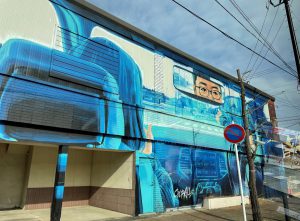
【Photos courtesy of MOE】
(3) Tomioka Wine Domaine (Tomioka)
In the town of Tomioka, all of the approximately 16,000 residents had to evacuate the town due to the nuclear accident. In the spring of 2016, Mr. Shubun Endo, a Tomioka resident who evacuated to Koriyama, began growing wine grapes in Tomioka, empty due to the evacuation orders, along with 9 other residents who had evacuated to places throughout the prefecture. They hoped to build a future for Tomioka by starting a new industry in this town which had lost everything. In April 2017, evacuation orders were lifted for around 90% of the town. Mr. Endo returned to Tomioka in August of that year, and while running his main construction consulting business also established Tomioka Wine Domaine in November 2018. The first harvest of grapes was completed in fall 2019, and in January 2020 their first wine was completed (made at a third-party winery). There are plans to use crowdfunding to expand the vineyards near Tomioka Station, as well as to build a winery with wine-making equipment and an attached store, with wine being used to restore vitality to this town everyone evacuated. The efforts by Mr. Endo and his associates to support the recovery by growing grapes were recognized at the 12th Regional Recovery Awards held in January 2022.
◆The tour will visit the vineyards and hear from Mr. Endo about the efforts of Tomioka Wine Domain, future plans, and his hopes for the recovery of Tomioka.
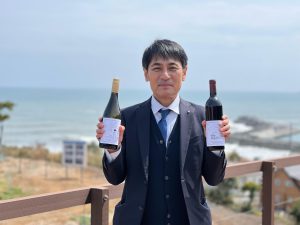
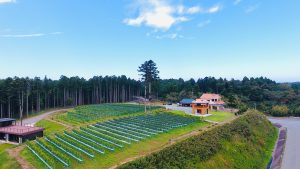
【Photos courtesy of Tomioka Wine Domaine】
(4) Fukushima Hydrogen Energy Research Field (Namie)
In March 2020, the Fukushima Hydrogen Energy Research Field (FH2R), one of the largest hydrogen production facilities in the world using renewable energy, began operations in Namie. With an area of 180,000 square meters, the electricity generated from the solar panels covering 80% of that area is used to extract hydrogen from water through electrolysis. The amount of hydrogen produced in one day is equivalent to what 150 average households would use in one month. The CO2-free hydrogen made at the FH2R was used as fuel for the Olympic torch’s brazier, as well as for fuel-cell vehicles used in the Tokyo 2020 Olympics and Paralympics held in 2021.
At the time of the disaster, approximately 21,434 people lived in Namie, but after the nuclear accident all the residents had to evacuate. Except for the difficult-to-return zones, the evacuation orders for Namie were lifted in March 2017, but only 1,844 people (as of the end of March 2022) currently live in the town. As a town which suffered due to a nuclear accident, Namie has high hopes for the next-generation clean-energy hydrogen being made at the FH2R as a central pillar for its recovery. Based on the Namie Hydrogen Town Framework the town announced in November 2020, the use of hydrogen energy is being promoted in the town, as well as encouraging businesses to carry out a variety of hydrogen-related trial projects, in an effort for local consumption of locally produced hydrogen. The town aims to bring in companies and the younger generation by becoming a pioneer in bringing about a hydrogen society.
◆The tour will visit the FH2R and see storage tanks, as well as hearing about Namie’s plans for using hydrogen as a base for recovery from the disaster and developing the town.
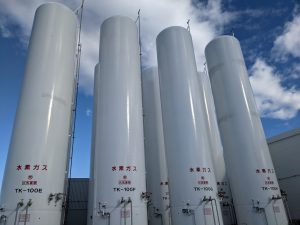
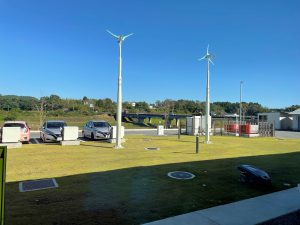
【Photos courtesy of MOE】
************
[Tour Itinerary]
1. Dates:
Wednesday, June 1 and Thursday, June 2, 2022
2. Schedule
*The schedule may change without notice due to weather or other reasons. Please be aware that depending on the state of the COVID-19 pandemic, the tour may be delayed or cancelled.
【Day 1】
07:12-08:30 Tokyo Station→Koriyama Station (Yamabiko 123)
10:30-11:45 Great East Japan Earthquake and Nuclear Disaster Memorial Museum
12:00-13:00 Ministry of the Environment Briefing
13:05-13:50 Lunch
14:10-16:00 Interim Storage Facility
16:30-18:30 Tomioka Wine Domaine
18:15 Arrive at hotel (stay overnight in Tomioka)
【Day 2】
09:00 Leave hotel
09:30-11:00 Tour town of Futaba (guided by Town Hall Officials)
11:40-13:00 Fukushima Hydrogen Energy Research Field (FH2R)
13:15-14:00 Lunch
15:10-17:10 Demonstration Project for Recycling (Nagadoro, Iitate Village)
19:16-20:48 Fukushima Station→Tokyo Station (Yamabiko 156)
3. Qualification:
Bearer of the Ministry of Foreign Affairs of Japan Press Registration Card
4. Cost:
13,000 yen per person including all travel and accommodation (breakfast and dinner included).
*Information on payment and cancellation fee will be provided to participants.
5. Participants:
10 participants (Only one reporter or one photographer from each media outlet, or two participants from each TV team will be allowed.)
*If the number of applicants exceeds ten, a limit could be set on the number of participants from each country/region.
6. FPCJ Contact:
Yamada (Ms.) and Watanabe (Ms.), Media Relations Division
(Tel: 03-3501-3405, email: ma@fpcjpn.or.jp)
7. Measures to prevent spread of COVID-19:
Please follow the directions of the staff, such as taking temperature before the tour, wearing a mask, washing hands, and using disinfectant. In the following cases, you will not be able to join the tour:
(1) If you have a fever of 37.5°C or over when your temperature is taken before the tour starts
(2) If, in the 14 days before the day of the tour, you had a fever, cough, sore throat or other symptoms of a cold, difficulties in tasting or smelling, fatigue, shortness of breath, or other symptoms
(3) If, in the 14 days before the day of the tour, you came into close contact with someone who tested positive for COVID-19
(4) If a family member living with you or other close acquaintance is suspected of having COVID-19
(5) If, in the 14 days before the day of the tour, you travelled to a country under travel restrictions designated by the Government of Japan and have not completed the self-quarantine period, or came into close contact with such a person
8. Remarks:
(1) This tour is sponsored by Ministry of the Environment and operated by the FPCJ.
(2) This tour will require participants to bear a part of the cost, but is not a profit-making venture.
(3) The Ministry of the Environment and the FPCJ take no responsibility for any accidents, injuries, illness, or other problems which occur during the tour. Tour participants should apply for travel insurance coverage individually should they decide it is necessary.
(4) There may be some restrictions on photographing and filming at the tour sites. Please follow the instructions of the staff in charge.
(5) Please be aware that videos and photos of the tour, and articles about it, may be posted by the Ministry of the Environment and the FPCJ on their websites or social media.



